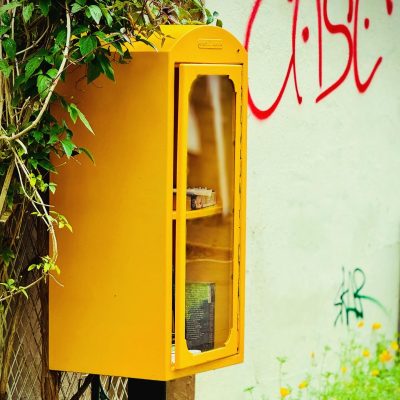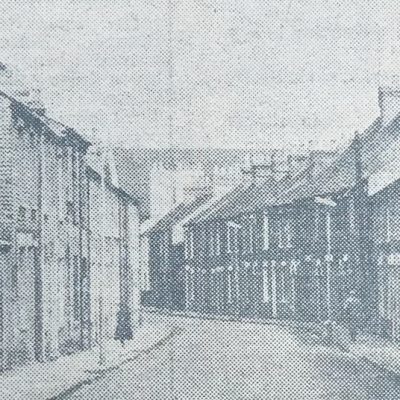Search by topic
- archaeology
- Building of Local Interest
- charity
- church
- crime
- dressmaker
- fire
- Great Eastern Railway
- Listed building
- Mapping Relief
- medieval
- oral history
- poverty
- Public House
- Rattee & Kett
- Religious House
- Roman
- scholar
- school
- Then and Now
- tudor
- women
- work
- world war one
- world war two
Search by text
Gwydir Street
History of Gwydir Street
Today, Gwydir Street is one of the most popular and sought after streets to own property on in the area, however in the mid-twentieth century it was considered a “slum”.
The name of the street comes from Baroness Gwydir, who owned land in this area, including Gwydir Street, before it was sold by her son to the Rev Dr James Geldart in 1809 and redeveloped. Her husband, Lord Gwydir’s estates lay in County Caernarvon, northern Wales.
The Dale’s Brewery building at the Mill Road end of Gwydir Street has gone through many ownerships from Pitson & Newman (1874), Percy Dyball, John Pamplin (1880), and in 1889 was closed and used as stabling. In 1902, Frederick Dale moved his brewery from behind the British Queen on Histon Road into the premises, which still bears his name today. Dales expanded rapidly and in 1911 was awarded for best beer at the Brewers International Exhibition. A seven-foot replica of the trophy was displayed on the roof until the 1960s.
From Mike Petty’s column “Memories” – 19 February 2003, Cambridge Evening News
In 1963, News columnist Erica Dimock surveyed Gwydir Street for her ‘Down Your Street’ feature. The terraced houses looked much the same as they had since they were built in the 1860s, but the atmosphere of the street had changed. It was becoming ‘the Soho of Cambridge’ as young families moved away to be replaced with people from Italy, Jamaica, Poland, Yugoslavia and a variety of other countries. One man who knew the street well was Harry Pateman, a magistrate. He had lived in the same house for 70 years and could remember when they had their own chemist’s shop amongst the facilities on offer. The number of shops had declined but still included three grocery stores: Ernest Mills had been trading for 14 years, S F Cockell had moved there in the mid 1950s, and C Harpur’s shop had changed hands only recently.
One newcomer was Sadie Segal who had brought her second-hand clothing shop from Norfolk Street, having been trading for 23 years, ever since she moved down from London during the war. But trade was not what it used to be, since people could now obtain almost anything on credit. Shoes would always be needed, and would always need mending. The British Shoe Corporation had its repair works in Upper Gwydir Street where some 1,300 pairs were repaired each week, as they had since 1914. But now things were changing and craftsmanship was being eliminated by new processes, stitching having been replaced by sticking.
Beer was an important part of the life of the street. Dale’s Brewery dominated the area near Mill Road. It had been founded in the 1890s, when there were no fewer than 22 breweries in Cambridge. But by 1963 it was being used as a distribution depot by Whitbread and its landmark 7ft high cup, a reminder of the gold cup won for the best beer at the Brewers’ International Exhibition in 1911, had been removed for safety reasons. Of the five public houses that had once traded, two were closed by 1963; the former Prince of Wales had been owned for a while by Peter Cook of Footlights and Beyond the Fringe frame and was then a Leslie Peck lodging house, the Gwydir Arms was a private house. The Brewer’s Arms had a good darts team, but the Alexandra Arms had lost its once-famous skittles club and at the Dew Drop Inn the licensee, Leslie Peck, was lamenting the recent closure of the Embassy Ballroom in Mill Road, that had considerably reduced his custom. (The Dewdrop is now the Cambridge Blue.) The Beaconsfield Conservative Club had itself formerly hosted dances in its imposing hall, then being used as a furniture warehouse, but both city and university judo clubs continued to meet in upper rooms. (The Beaconsfield Club closed down in 1984 after it lost its licence because of complaints of noise and fighting.)
It is hard to associate urban Gwydir Street with exotic snakes, lizards or spiders, but they were a regular hazard for H W Barnes, director of Whitehead’s wholesale fruit and vegetable warehouse. They had hanging space for 900 stems of bananas some containing creepy crawlies, a quite impressive sight, and something like seven tons were received and despatched each week. Although oranges and South African apples were still very popular there was an increasing demand for more unusual fruit and continental produce.
Over the years there have been redevelopments of the Bath House, Dales Brewery and the Pye site on the street to provide places for small businesses, local groups, and some new residential building. Bollards installed on Gwydir Street in the 1980’s stopped the local roads being used as a short cut by traffic.
In 2019, David Parr House – a preserved terraced house on Gwydir Street containing an extraordinary secret world of an Arts & Crafts Worker’s home – opened to the public for guided tours.
Find out more about Gwydir Street on The Edkins website here.
Gwydir Street Friends
In 2019, the local residents founded a non-hierarchical community group, through which they organise initiatives to encourage friendship and exchange, share the street’s cultural heritage and promote biodiversity such as:
- This Is Our Street! – intergenerational cultural heritage project
- becoming Cambridge’s first official Hedgehog Highway in 2019
- Gwydir Street Window Box & Hanging Basket Competition as part of a Petersfield street greening initiative developed in partnership with the city council.
- Festive Windows display each December since 2020
Street Parties on Gwydir Street
Gwydir Street has garnered a reputation over the years for organising Summer parties on the street for the local residents, including for Jubilee and coronation celebrations. Find out more about the street parties here.

The Mayor of Cambridge opens the Gwydir Street Tea Party 2019 with a samba band parade by local group Arco Iris.
Contribute
Do you have any information about the people or places in this article? If so, then please let us know using the Contact page or by emailing capturingcambridge@
License
This work is licensed under CC BY-NC-SA 4.0










